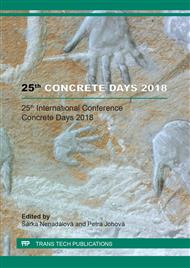p.183
p.191
p.197
p.203
p.210
p.217
p.224
p.230
p.236
B4 Model Adaptation for Prediction of UHPC Strains from Creep and Shrinkage
Abstract:
High compressive strength of ultra-high performance concrete (UHPC) defines high level of compressive strains of UHPC structural elements when efficiently designed. Significant effects are rheological changes in the concrete mixture caused by creep and shrinkage. To design reliable structures with sufficient level of prestressing, it is necessary to determine and predict the magnitude of creep and shrinkage strains of UHPC. Creep and shrinkage model B4 is currently used as most advanced material model based on great consistency with large set of experimental results and measurements on real structures and bridges. It seems to be viable for use for prediction of creep and shrinkage strains of UHPC as it predicts long-term strains by incorporating effect of volume of additives and admixtures used in the fresh concrete. Model B4 also takes into effect thermal treatment of fresh concrete, which accelerates cement hydration in early age. For UHPC mixture is characteristic very low water to cement ratio which is compensated by adding superplasticizers. UHPC mixture also contains large volumes of fine ground additives, most common is silica fume. Current model B4 has several limitations that are often exceeded by characteristics of UHPC. In this paper, these limitations are identified and viable adaptation of model B4 is presented.
Info:
Periodical:
Pages:
210-216
Citation:
Online since:
June 2019
Authors:
Price:
Сopyright:
© 2019 Trans Tech Publications Ltd. All Rights Reserved
Share:
Citation:


